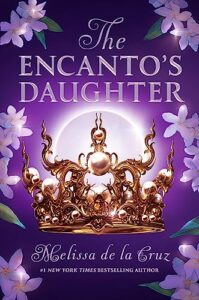 Review By: Sara Tripp
Review By: Sara Tripp
Published: 2024
Genres: Fantas-y, Young Adult, Romance, Mythology, Fiction, Mystery, Magic, Contemporary, Paranormal
Audience: 8-9; Young Adult
Content Warnings: murder, dark magic
Goodreads Link: The Encanto’s Daughter
Publisher’s Summary
A young woman claims the throne of a realm inspired by Filipino mythology in this YA romantic fantasy, the first in an enchanting new duet by #1 New York Times bestselling author Melissa de la Cruz. MJ Rodriguez has spent her life hiding in the human world, keeping a heavy secret. She’s half-encanto. As the only child of King Vivencio of the Sirena Court, she’s also next in line for the throne. And now, upon her estranged father’s sudden death, MJ must claim her place as rightful heir.
In wondrous Biringan, the road to the throne is paved with thorns. Without a reigning monarch, the realm has spiraled into disarray. MJ has to win over a backstabbing council that objects to a half-human ruler. And when it looks like her father’s passing wasn’t natural but possibly inflicted by a curse, she must hunt down the sorceress behind this merciless magic. In a bind, MJ forges an unlikely alliance with the striking Sir Lucas of the feared Sigbin Court, and soon, she loses her heart to the mysterious knight. But with peril looming over Biringan, the princess must decide if she can both open herself to love and carry the weight of the crown.
Review Text
As a high school teacher, I was interested in The Encanto’s Daughter by Melissa De la Cruz, hoping it would be an enjoyable and engaging read that could potentially appeal to my students. However, my experience with the book was less favorable than I anticipated, as I found it difficult to appreciate fully.
The core plot—about a young girl uncovering her magical heritage—has potential, but this potential is diluted by long stretches of irrelevant information. These details often sidetrack the narrative, pulling focus away from the more compelling aspects of the story. Rather than enhancing the world-building or character development, these tangents often felt distracting, making it hard to stay engaged with the plot.
The pacing was another issue I encountered. While there are moments of action and intrigue, they are frequently interrupted by passages that go into depth on less significant facts or background, which didn’t seem to add much value to the overall story. This slowed the book down, and I often found myself losing interest.
Additionally, the main character, while likable, didn’t undergo enough growth or development to make her journey as engaging as it could have been. The magical elements, which should have brought excitement and wonder, were often overshadowed by an overwhelming amount of explanation and description that made the narrative feel sluggish.
In terms of educational value, The Encanto’s Daughter does touch on themes like identity and self-discovery, which are important for young adult readers. However, I believe many students might struggle with the pacing and feel as if they’re wading through too much unnecessary information to get to the heart of the story.
In summary, The Encanto’s Daughter had the potential to be an interesting and engaging read but ultimately fell short due to the abundance of unimportant details that detracted from the main plot. While some readers might enjoy the intricate descriptions, I found it hard to stay invested in the story and wouldn’t readily recommend it for a high school classroom setting.



